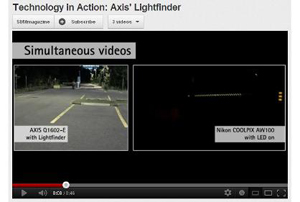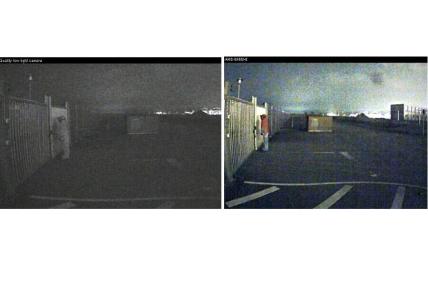
|
|
When showing video footage from any of Axis’ Lightfinder-enabled cameras, sometimes the reaction isn't as drastic as anticipated. That's because the viewer has nothing to compare the video too. It just looks like a video shot in decent lighting at night. |
The ability to deliver clear, color video in low-light conditions — a first for the video surveillance world — is what earned Axis’ Lightfinder technology a prestigious Wall Street Journal Technology Innovation Award. Surveillance cameras traditionally switch to black-and-white when light drops below a certain lux level. This traditional day/night functionality provides a clearer image with less noise, but key color video details to assist in identification are missing. Thanks to ongoing investment in research and development with a tireless search to find the perfect combination of the right sensor, lens, and image processing, Axis’ groundbreaking Lightfinder technology has made it possible to see color in the dark.
SDM interviewed Martin Gren, Axis Communications co-founder, Johan Paulsson, Axis Chief Technology Officer (CTO), Andres Vigren, Axis product manager, Fixed Network Cameras,to find out how Lightfinder went from idea to reality in this exclusive Q & A.
SDM: What exactly is Lightfinder?
Paulson:When a conventional day/night camera would switch to black and white mode in darkness, a Lightfinder camera maintains color video — this is perfect for security applications that require color for recognition and identification. Beyond color in the dark, Lightfinder also provides smooth, crisp video of moving objects where traditional cameras would experience noise and image blur. It’s a result you have to see to believe, and watching a side-by-side comparison video is the best proof. See Axis' Lightfinder technology in action in an impromptu demo from an Axis regional sales manager at http://www.youtube.com/watch?v=x-XIlByytgk&feature=plcp.
SDM: Why was this technology developed?
Gren: Axis is a networking company with 100 percent devotion to IP video. Unfortunately, analog cameras were still seen as performing better in low light. It was the old technology’s last real advantage. If digital video surveillance was to truly make analog video irrelevant, there was a clear need for a light-sensitive digital camera that could outperform its analog counterparts. After years of working on a solution, the timing was right when advancements in lens and sensor technology coincided with the launch of Axis’ own ARTPEC-4 chipset.
SDM: So how does it work?
Vigren: Without giving away too much secret sauce, Lightfinder actually uses a CMOS sensor with exceptional light sensitivity. In fact, Johan has a funny story about the sensor selection process.
Paulson: Yes, it’s also a perfect story about how the boss isn’t always right. Over the years I got a bit irritated hearing how the best low-light cameras were analog and used an interlaced, CCD sensor. Why couldn’t we develop the greatest low light network camera using the best analog D1 sensor? So I gave the order to our product teams to develop a full frame rate IP camera using the latest analog sensor. Our engineers were not too happy about using this sensor type, but of course went ahead with the project.
I saw the first early prototype and the results were amazing. When the project was officially approved, the team looked very happy and let me in on a secret: They never fully accepted my sensor decision. While they initially tested the idea, they instead challenged themselves to beat the best analog camera with a true network camera progressive scan sensor. This small team isolated the old low-light network camera sensor issue and managed it amazingly well. Lightfinder was born that day and first launched in the AXIS Q1602 in 2011.
Vigren: But the sensor is just one of three parts to the Lightfinder equation. This CMOS sensor is combined with the right lens to maximize image quality. The third component — Axis’ in-camera chip — is likely the most important one. The chip’s processing technology, which is a staple of all our network video products, drives elaborate software inside the camera that sets the degree of filtering and sharpening so that the best possible image quality is achieved. This perfect combo of chip, sensor and lens are essential components of a technology that can see color in low light while reducing blur and noise.
SDM: What kind of feedback do you get when Lightfinder is implemented?
Gren:One of the first tests was carefully questioned by one of my own bosses: my then seven-year-old daughter. I had taken a prototype home and we were walking through our garden together at night. I was really excited with how clear the video look. That was until my daughter said, “Daddy, this camera is broken.” This shocked me a bit, so I asked what she meant. She said, “Well, the sky on the video. It’s blue. But look up, it should be black. Something is wrong.”
The camera wasn’t broken — it was working better than we had hoped. What most people don’t know is that the sky is blue in day and night. Lightfinder can even see the colors we can’t and gave my daughter a lesson about the sky to tell her classmates.
Vigren: Cameras with Lightfinder can also see objects and people hidden in darkness or shadows (see image of low light analog vs. Lightfinder). Instead of having a black and white video of a person wearing what’s reported as a “dark-colored coat,” the video will show that a person in a red coat left in a green car at 11 at night. And, when the car drives away, there is significantly less motion blur even in very low light. Technically speaking, the AXIS Q1602 produces color video down to .05 lux, which is even lower than a quarter moon on a clear night.
Gren: And now that we have bested analog in low light, this technology will be a big benefit for all industry segments. Parking lots, city surveillance, parks and campuses have all been popular installation applications. So have railways, tunnels, subways and critical infrastructure. Anyone who needs color and forensic detail at all hours of the day is a potential customer.
SDM: What will the future bring for Lightfinder and low-light solutions?
Paulson: To an extent, the future is happening now. As Andres said, we started with Lightfinder in a fixed box camera with the AXIS Q1602. Next we rolled out the technology into our popular AXIS P33 Series fixed dome cameras at ISC in 2012. Then, before ASIS, we launched the first camera that included both Lightfinder and our latest wide dynamic range technology — dynamic capture — with the AXIS P3384 fixed dome. So we’re continuing to develop products across the whole portfolio with the same high degree of light sensitivity that Lightfinder has — but with even better resolution.
The key features of any future imaging technology will be improved light sensitivity and reduced noise in the highest resolution. We’ll continue to use the latest sensor technology and will continue to develop smarter software to lead to faster product development in the low-light application market.
Gren: The end goal is always to build the best IP cameras that can see better than the human eye in every condition. We’re getting very close and, with low light, we’re already there.






